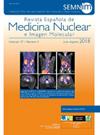PET/TC con 18F-colina en el estudio del hiperparatiroidismo primario: evaluación de la técnica, análisis visual y semicuantitativo y correlación con otras técnicas de imagen
IF 1.6
4区 医学
Q3 RADIOLOGY, NUCLEAR MEDICINE & MEDICAL IMAGING
Revista Espanola De Medicina Nuclear E Imagen Molecular
Pub Date : 2025-08-18
DOI:10.1016/j.remn.2025.500129
引用次数: 0
Abstract
Objective
To assess the usefulness of performing a dual-time-point protocol in the acquisition of 18F-Choline (18F-FCH) PET/CT in the pre-surgical localization of PHPT, and to demonstrate the impact of this imaging technique on the management and outcome-based surgical decision making, compared to other imaging techniques. To evaluate the diagnostic performance of the test to discriminate between pathological parathyroid gland and cervical lymph node, as well as to establish its correlation with other imaging techniques (scintigraphy, ultrasound, CT and MRI).
Patients and methods
We included 39 patients who underwent surgery for PHPT, in whom dual-time-point 18F-FCH PET/CT was performed. Metabolic index of parathyroid (P-SUVmax; P-SUVpeak), lymph node (N-SUVpeak), thyroid (T-SUVpeak) and mediastinum (M-SUVpeak) uptake were analyzed visually and semiquantitatively in both images. PET/CT results were correlated with 99mTc-MIBI scintigraphy, ultrasound, MRI and CT.
Results
In 36 patients (92%), PET/CT was positive, localizing 38 pathological glands. The sensitivity (S) of PET/TC was 97% and positive predictive value (PPV) 94%. In the visual analysis, dual-time-point protocol was necessary in 61% of the cases. Correlation between PET/TC with MRI was 80%, with 4D-CT 50%, and with the other techniques < 50%. P-SUVmax shows correlation with adenoma weight and size, and with presurgical PTH. The best cutoff point for SUVpeak to differentiate parathyroid vs. lymph node was 2.6 in early images (S = 70%; specificity = 75%; P=.007) and 0.86 for SUVpeak/T-SUVpeak index (S = 73%; specificity = 69%; P=.001).
Conclusion
18F-FCH PET/CT is an excellent preoperative localization technique in patients with PHPT with negative, doubtful or inconclusive imaging techniques, being of vital importance in guiding minimally invasive surgery. The dual-time-point protocol was necessary in more than half of the cases (61%). The SUVpeak cut-off points to discriminate between parathyroid gland and lymph nodes were statistically significant.
在原发性甲状旁腺增生研究中使用18F-胆碱的PET/TC:技术评估、视觉和半定量分析以及与其他成像技术的相关性
目的评估采用双时间点方案获取18f -胆碱(18F-FCH) PET/CT在PHPT术前定位中的有效性,并与其他成像技术相比,展示该成像技术对治疗和基于结果的手术决策的影响。评价该检查对病理性甲状旁腺和颈淋巴结的鉴别诊断价值,并与其他影像学技术(闪烁成像、超声、CT、MRI)建立相关性。患者和方法我们纳入了39例接受PHPT手术的患者,其中进行了双时间点18F-FCH PET/CT检查。对两幅图像的甲状旁腺代谢指数(P-SUVmax; P-SUVpeak)、淋巴结代谢指数(N-SUVpeak)、甲状腺代谢指数(T-SUVpeak)和纵隔代谢指数(M-SUVpeak)摄取进行目视和半定量分析。PET/CT结果与99mTc-MIBI显像、超声、MRI和CT结果相关。结果PET/CT阳性36例(92%),病灶腺体38个。PET/TC敏感性(S)为97%,阳性预测值(PPV)为94%。在目视分析中,61%的病例需要双时间点方案。PET/TC与MRI的相关性为80%,与4D-CT的相关性为50%,与其他技术的相关性为50%。P-SUVmax与腺瘤重量、大小及术前PTH相关。早期SUVpeak鉴别甲状旁腺与淋巴结的最佳截断点为2.6 (S = 70%,特异性= 75%,P= 0.007), SUVpeak/T-SUVpeak指数的最佳截断点为0.86 (S = 73%,特异性= 69%,P= 0.001)。结论18f - fch PET/CT对于影像学阴性、可疑或不确定的PHPT患者是一种很好的术前定位技术,对指导微创手术具有重要意义。超过一半的病例(61%)需要双时间点方案。区分甲状旁腺和淋巴结的SUVpeak截止点具有统计学意义。
本文章由计算机程序翻译,如有差异,请以英文原文为准。
求助全文
约1分钟内获得全文
求助全文
来源期刊

Revista Espanola De Medicina Nuclear E Imagen Molecular
RADIOLOGY, NUCLEAR MEDICINE & MEDICAL IMAGING-
CiteScore
1.10
自引率
16.70%
发文量
85
审稿时长
24 days
期刊介绍:
The Revista Española de Medicina Nuclear e Imagen Molecular (Spanish Journal of Nuclear Medicine and Molecular Imaging), was founded in 1982, and is the official journal of the Spanish Society of Nuclear Medicine and Molecular Imaging, which has more than 700 members.
The Journal, which publishes 6 regular issues per year, has the promotion of research and continuing education in all fields of Nuclear Medicine as its main aim. For this, its principal sections are Originals, Clinical Notes, Images of Interest, and Special Collaboration articles.
 求助内容:
求助内容: 应助结果提醒方式:
应助结果提醒方式:


